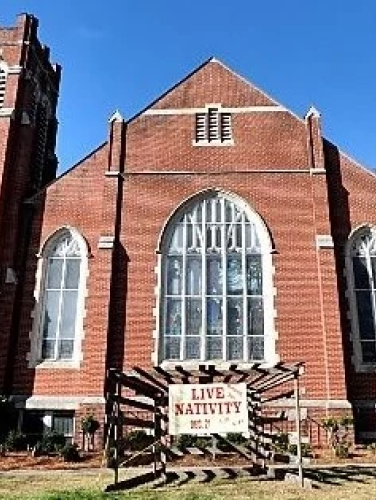
Hawthorne Lane United Methodist Church
(ca. 1916)
The founders of the Louis Asbury-designed Hawthorne Lane Methodist Church included several prominent members of Charlotte’s business community.
501 Hawthorne Ln, Charlotte, NC 28204
Following two years of preliminary committee work to investigate the need for a Methodist church to serve the Elizabeth and Piedmont Park neighborhoods, the congregation of Hawthorne Lane Methodist Church was organized in 1914. Among the charter members of the new congregation were some of the most prominent members of Charlotte’s business community, including Joseph B. Ivey (1864-1958), founder of the Ivey’s department store, Benjamin D. Heath (1849-1919), founding president of Charlotte National Bank, and Eusebius A. Cole (1870-1943), co-founder of the Cole Manufacturing Company.
Property Quick Links
The congregation held its first service on December 5, 1915, at Elizabeth College and Conservatory of Music (now Novant Health Presbyterian Medical Center), where they continued to meet until the completion of the Hawthorne Lane sanctuary. The congregation selected Charlotte native Louis Humbert Asbury, Sr. (1877-1975), one of North Carolina’s first professionally trained architects and one of the region’s foremost building designers of the early twentieth century, to design the new church.
The first service in the new Gothic Revival style church was held on December 3, 1916. Asbury used the “Akron Plan” for the Hawthorne Lane facility, a popular church design of the period that incorporated roll-up partitions to divide the building into classroom and sanctuary sections. Built upon land donated by Benjamin Heath, the sanctuary features two large stained-glass windows, one depicting John Wesley speaking on the grave of his father and the other showing a young Jesus in the Temple of Jerusalem.
The primary significance of Hawthorne Lane Methodist lies in its role as a neighborhood church for the Elizabeth neighborhood, Charlotte's second oldest streetcar suburb. Until the construction of Myers Park, Elizabeth was Charlotte's most fashionable suburban address. The new congregation quickly became involved in a range of missionary and outreach activities, including providing social activities at Camp Greene during World War I, contributing to the Florence Crittendon Home and the Bethlehem Center, and sponsoring missionaries in India and Japan. One of the most well-known members of the Hawthorne Lane congregation was Hal Kemp, a band leader popular in the 1930s who began his musical career in Hawthorne Lane Methodist’s Sunday School Orchestra.
Asbury studied architecture at the Massachusetts Institute of Technology before returning to his hometown to open his firm in 1908. As North Carolina’s first member of the American Institute of Architects, Asbury earned hundreds of commissions in Charlotte and the surrounding counties. His notable body of work includes the 1921 Thies Automobile Sales and Service Building, the 1926 Mecklenburg County Courthouse, the 1927 First National Bank skyscraper on South Tryon Street, the 1918 Old Mount Carmel Baptist Church building, and the 1928 Myers Park Methodist Church building, as well as numerous stately homes throughout Charlotte.

